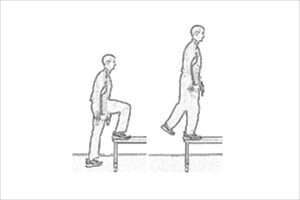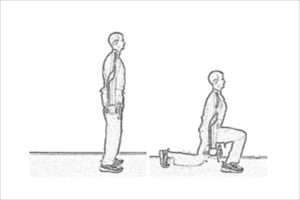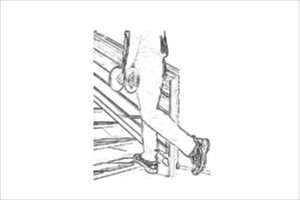Building strong and powerful legs is crucial for martial artists. Stronger stances, better kicking power, and improved movement control are all benefits of developing powerful legs. This guide introduces four effective dumbbell exercises specifically designed to improve leg strength, balance, and stability.
Deadlift.

Bend at the knees and hips until the weights touch the floor, all the while maintaining a straight back. Then, with a swift motion, extend your legs to stand upright once more.
It primarily targets your lower back, glutes, hamstrings, and traps, but it’s a full-body exercise that engages various muscle groups.
How to:
- Stand with feet hip-width apart, dumbbells on the side. Shoulders a little to the back and chest out.
- Bend at hips and knees, until you reach a “sitting” position, and keep your back straight (do not go all the way down if you have knee problems).
- Lift by extending the legs, keeping a straight back.
- Repeat.
Pros:
- Strength and Power: Deadlifts are exceptional for building overall strength and power. They’re a key exercise in powerlifting for a reason.
- Functional Strength: This movement mimics real-life lifting scenarios, making it valuable for everyday activities.
- Posture Improvement: Deadlifts encourage good posture and help in strengthening your lower back.
- Muscle Engagement: It’s a compound exercise, engaging multiple muscle groups, and saving time in the gym.
Cons:
- Technique: Deadlifts require a proper form to prevent injury. Incorrect form can strain your lower back.
- Risk of Injury: If not performed correctly or with excessive weight, deadlifts can lead to back or disc injuries.
- Intense: They are physically demanding. If you’re new to weightlifting, start with lighter weights and gradually increase.
- Recovery Time: Deadlifts can leave you feeling sore for a few days, so ensure you allow your muscles to recover.
Incorporate deadlifts into your routine cautiously, with proper guidance, and gradually increase the weight as your strength and form improve. They are fantastic exercises for building a strong and functional body, but safety and technique should always come first.
Step-ups.

Step-ups on a bench are a well-known lower body exercise that involves stepping onto a bench or platform one leg at a time. This exercise targets your quads, hamstrings, glutes, and even engages your calves. It’s excellent for building lower body strength and can be adjusted to your fitness level.
How to:
- Stand in front of a bench or sturdy platform with a dumbbell in each hand.
- Place one foot onto the bench.
- Step up until your leg is fully extended and you’re standing on the bench.
- Gently lower yourself back down with control using the same leg.
- Perform one set for each leg at a time.
Pros:
- Leg Strength: Step-ups primarily target the muscles in your legs, including the quadriceps, hamstrings, and glutes, helping to build strength and definition.
- Balance and Coordination: They improve balance and coordination, as you have to stabilize yourself while stepping up and down.
- Versatility: You can adjust the height of the bench or platform to increase or decrease the challenge, making it suitable for various fitness levels.
- Functional Fitness: This exercise mimics activities like climbing stairs or hiking, enhancing your ability to perform daily tasks.
- Minimal Equipment: It can be done with minimal equipment, making it a convenient choice for home workouts.
Cons:
- Knee Stress: If not performed with proper form, step-ups can put stress on the knees, potentially leading to discomfort or injury.
- Balance Challenge: While balance is a benefit, it can also be a drawback for beginners or those with balance issues.
- Potential for Overuse: Overdoing step-ups or using excessive weight can lead to overuse injuries or muscle imbalances.
- Monotonous: Some people may find step-ups to be a bit monotonous, as it’s a repetitive movement.
- Limited Upper Body Engagement: Step-ups primarily focus on the lower body, so they don’t offer a comprehensive full-body workout.
As with any exercise, proper form is essential to avoid injury. If you have concerns about your knees or balance, consider starting with a lower platform or consulting a fitness professional. Step-ups can be a valuable addition to your routine if done correctly and in moderation.
Lunges.

Lunges are a fundamental lower body exercise. Here’s a description:
From a standing position, take a step back with one foot, lowering your body until both knees are bent at 90-degree angles. Then, push through your front heel to return to a standing position. Lunges are a great way to target your quadriceps, hamstrings, and glutes, while also improving your balance and stability.
How to:
- Stand upright with your feet together.
- Take a step forward with one leg and lower your body until both knees are bent at 90-degree angles.
- Push back up through your front heel to return to a standing position.
- Perform the same movement with the other leg.
- Alternate legs for each repetition.
Pros:
- Leg Strength: Lunges are excellent for building strength in your quadriceps, hamstrings, and glutes.
- Balance and Coordination: Performing lunges helps improve balance and coordination, making it a functional exercise for everyday activities.
- Versatility: Lunges can be modified in various ways, such as forward lunges, reverse lunges, or lateral lunges, to target different leg muscles.
- Minimal Equipment: You can do lunges without any equipment, making them suitable for home workouts.
Cons:
- Knee Stress: If not performed with proper form, lunges can strain the knees. It’s crucial to ensure your front knee doesn’t extend beyond your toes.
- Balance Challenge: Lunges can be challenging for beginners or individuals with balance issues. Using a chair or wall for support can help.
- Overuse Injuries: Like any exercise, overdoing lunges can lead to overuse injuries. Be sure to balance your workout routine.
- Limited Upper Body Engagement: Lunges primarily focus on the lower body and don’t provide a comprehensive full-body workout.
- Lunges are a valuable exercise for building lower body strength and functional fitness. Proper form is essential, and it’s a good idea to incorporate them into a well-rounded workout routine.
Calf Raises.

Calf raises are a simple yet effective exercise that primarily targets the calf muscles. They involve raising your heels while standing on the balls of your feet. This exercise can be performed with or without added weight and is a great way to strengthen and tone your calf muscles.
How to:
- Stand upright with your feet hip-width apart.
- You can do this exercise with body weight or by holding dumbbells or a barbell across your shoulders.
- Lift your heels as high as possible by pushing through the balls of your feet.
- Hold the raised position briefly.
- Lower your heels back down until they’re slightly below the level of the floor.
- Repeat for the desired number of repetitions.
Pros.
- Calf Strength: Calf raises help build strength and endurance in the calf muscles, which can improve athletic performance and lower-leg function.
- Toned Calves: Regularly performing calf raises can result in toned and defined calf muscles, which can enhance the aesthetics of your legs.
- Versatility: This exercise can be done with minimal equipment, making it suitable for home workouts.
- Improved Balance: It can help improve balance and stability, which can be beneficial for various activities.
Cons.
- Limited Muscle Engagement: Calf raises primarily target the calf muscles and do not provide a comprehensive full-body workout.
- Potential for Overuse: Overdoing calf raises, especially with heavy weights, can lead to overuse injuries or muscle imbalances.
- Lack of Variety: While effective, calf raises may become monotonous for some individuals as they primarily work on one muscle group.
- Incorporate calf raises into your workout routine to strengthen your calf muscles, improve balance, and achieve toned lower legs. As with any exercise, it’s essential to use proper form and avoid overloading the muscles to prevent potential drawbacks.
Summary.
Investing time in your leg workouts is a vital step in becoming a well-rounded martial artist. Your newfound leg strength and agility will serve as a sturdy base for your martial arts journey, improving your stability, speed, and power. Consistent training will not only enhance your techniques but also reduce the risk of injury, allowing you to train harder and longer.
Thanks for reading.
Cheers, Gert
